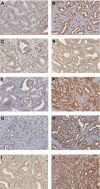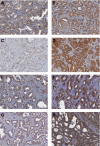Hierarchical clustering of immunohistochemical analysis of the activated ErbB/PI3K/Akt/NF-kappaB signalling pathway and prognostic significance in prostate cancer
- PMID: 20216540
- PMCID: PMC2853085
- DOI: 10.1038/sj.bjc.6605571
Hierarchical clustering of immunohistochemical analysis of the activated ErbB/PI3K/Akt/NF-kappaB signalling pathway and prognostic significance in prostate cancer
Abstract
Background: The PI3K/Akt signalling pathway, induced by epidermal growth factor receptor (EGFR) and Her-2, is involved in the constitutive activation of NF-kappaB in prostate cancer cell lines. In this study, we extended the in vitro observation using an ex vivo model of prostate cancer tissues and assessed the prognostic significance of the PI3K/Ak/NF-kappaB signalling determinants.
Methods: We analysed a prostate cancer tissue microarray of 63 patients for the expression of total and activated EGFR, Her-2 receptors and the signalling molecules PTEN, phospho-PTEN, Akt, phospho-Akt and the NF-kappaB subunit p65. Data were analysed using Spearman's rho test, Kaplan-Meier curves and multivariate Cox regression analysis. In addition, a non-supervised hierarchical clustering analysis was applied to stratify patients according to prognostic groups in terms of risk of recurrence.
Results: The concomitant overexpression of activated EGFR and Her-2 was correlated with the nuclear expression of NF-kappaB. EGFR, phospho-EGFR, phospho-Her-2, ErbB3 and nuclear NF-kappaB were associated with the overall biochemical recurrence (BCR) of patients. The non-supervised hierarchical clustering analysis resulted in the separation of patients into five groups according to BCR.
Conclusions: These results validate the previous in vitro data on ErbB involvement in NF-kappaB activation and shows evidence for a significant role of ErbB/PI3K/Akt/NF-kappaB signalling in the progression of prostate cancer.
Figures





References
-
- Bedolla R, Prihoda TJ, Kreisberg JI, Malik SN, Krishnegowda NK, Troyer DA, Ghosh PM (2007) Determining risk of biochemical recurrence in prostate cancer by immunohistochemical detection of PTEN expression and Akt activation. Clin Cancer Res 13: 3860–3867 - PubMed
-
- Bublil EM, Yarden Y (2007) The EGF receptor family: spearheading a merger of signaling and therapeutics. Curr Opin Cell Biol 19: 124–134 - PubMed
-
- Cicenas J, Urban P, Kung W, Vuaroqueaux V, Labuhn M, Wight E, Eppenberger U, Eppenberger-Castori S (2006) Phosphorylation of tyrosine 1248-ERBB2 measured by chemiluminescence-linked immunoassay is an independent predictor of poor prognosis in primary breast cancer patients. Eur J Cancer 42: 636–645 - PubMed
-
- Di Lorenzo G, Autorino R, De Laurentiis M, Cindolo L, D’Armiento M, Bianco AR, De Placido S (2004) HER-2/neu receptor in prostate cancer development and progression to androgen independence. Tumori 90: 163–170 - PubMed
-
- Di Lorenzo G, Tortora G, D’Armiento FP, De Rosa G, Staibano S, Autorino R, D’Armiento M, De Laurentiis M, De Placido S, Catalano G, Bianco AR, Ciardiello F (2002) Expression of epidermal growth factor receptor correlates with disease relapse and progression to androgen-independence in human prostate cancer. Clin Cancer Res 8: 3438–3444 - PubMed
Publication types
MeSH terms
Substances
LinkOut - more resources
Full Text Sources
Medical
Research Materials
Miscellaneous

